 | E-mail to Birds Korea |
 | KWBS |
in the Region
 | The Oriental Bird Club |
 | BirdLife International (Asia) |
September
Temperatures begin to cool, especially towards the end of the month, with maxima often falling from 28°C to 20°C. Sunny, dry weather predominates, though often punctuated by occasional heavy rain and very strong winds associated with typhoons.
September sees migration pick up considerably, with a build-up of ducks including the first returning flocks of Baikal Teal by mid-month especially. Seabirds still provide much interest (with increasing numbers of jaegers and dark shearwaters), while shorebirds and Yellow Sea "specials" remain widespread and numerous: highlights have included the world's largest concentration of Spoon-billed Sandpipers (with a peak at Saemangeum of 200 in the late 1990s, likely 10% of the total world population), Nordmann's Greenshank, and up to 170 Black-faced Spoonbill at Ganghwa.
Whiskered and White-winged Black Terns, although scarce in South Korea, become rather more widespread with small flocks of the latter at Seosan especially, along with an increasing number of Mongolian Gull. Raptor migration includes large concentrations of Chinese Sparrowhawk making their way towards Japan (where over 50 000 have been recorded in one day on an island in the Korean Straits only 40 km south of Busan!), along with smaller flocks of Grey-faced and Crested Honey Buzzards, and very small numbers of Pied Harrier and Amur Falcon especially through the west and northwest.
Passerines become rather more numerous and diverse, with Thick-billed Warbler and Brown Shrike early in the month, good numbers of Yellow Wagtail (including the highly attractive taivana), Pechora Pipit, and the three species of "grey-brown flycatchers" by mid-month (some Dark-sided and Brown still, with a peak in Grey-streaked). Towards the very end of September, Olive-backed and Buff-bellied Pipit migration starts in earnest, and the first small flocks of buntings also arrive, with most numerous being Chestnut and Black-faced.
September highlights include both Korean records of Rose-coloured Starling (2002 and 2004), 2 Eurasian Tree Pipits on Eocheong island in 2002, and in 2003, an Ashy Drongo on Socheong Island, with 1 or 2 South Polar Skua seen at sea nearby, Korea's first Steppe Grey Shrike (2004), and the country's first Dotterel, found at Seosan in 2005.
(The following records are a compilation of our own sightings and records sent in by other observers. As well as being posted on the Birds Korea website(s), selected records are also forwarded to other Korean-language birding websites; records of threatened species are arranged and forwarded to Birdlife International and national authorities when appropriate; flag images and records are passed to bodies responsible for their coordination throughout the flyway; and all records sent to us are used to compile annual reports and to support the evolving understanding of the status of many of Korea’s birds.)
Geum Estuary, September 26
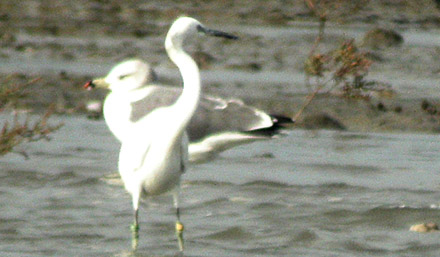
Photo © Nial Moores/Birds Korea
A few hours at the Geum estuary on the rising tide were productive, with more than 800 Common Greenshank and over 900 Black-tailed Godwit, along with single Ruff, Common Redshank and a limited mix of other shorebird species, including 10 Red Knot. Also there, a single Falcated Duck, a Whiskered Tern (adult moulting into non-breeding plumage) and a Crested Honey Buzzard over.
The highlight came at Shellfish harbor, when Angela's sharp eyes picked out color rings on one of the 22 Chinese Egret present: information is being sought on when and where this bird might have been banded.
Saemangeum and Geum, September 24 and 25
As part of a week-long effort to promote the SSMP, a series of workshops (in Seoul, Jeonju and Incheon), birding, basic habitat assessment and some limited counting.
On 24th, Simpo supported several thousand shorebirds (many too distant to identify, but mostly Dunlin), with unexpected highlight there two male Chestnut-cheeked Starling, while the Geum near the barrage held a single Ruff, small numbers of Black-tailed Godwit and several hundred Common Greenshank.
On 25th, the tidal-flats near the airport were checked, but now appear very shorebird poor when compared to the spring.
Two afternoons at Yubu Island at high tide were predictably much more productive. Apart from 4+ Chinese Egret (on 25th), 2 Northern Boobook and an Oriental Cuckoo (both on 25th), shorebirds showed extremely well in good light, despite regular harrassment by a Northen Hobby, 2 Kestrel and a Peregrine.
Species in internationally important concentrations, counted and estimated in a number of ways, included Far Eastern Curlew (990), Eurasian Curlew (1450), Grey Plover (1200), Mongolian Plover (2115), Kentish Plover (2670), Dunlin (5750), Broad-billed Sandpiper (600+), Eastern Oystercatcher (495), Sanderling (ca 600?), with 90 Pacific Golden Plover on 24th probably a national high count.
In addition to these superb numbers, there were over 1000 Red-necked Stint with outstanding highlights 31-37 Nordmann's Greenshank (2 juveniles; the rest adults) and at least 15 Spoon-billed Sandpiper, with a minimum 6 juveniles and one leg-flagged adult (light green on right tibia), watched feeding at close to medium range.
Hong Island, September 21
An excellent day with a Tree Pipit photographed and even more outstanding, views of a Swinhoe's Rail at best down to 1 m! The last record of this vulnerable species in Korea was one banded on Hong Island on 28 October, 2005 - the first after a 70 year gap.
Seosan A, September 17
On a miserable day that was truly one for the birds, the northern end of the lake led to a roost of c. 80 Black-crowned Night Heron, a Yellow Bittern, Oriental Cuckoo and seasonal birds Pintail, Baikal Teal, Common Shelduck, Great Crested Grebe and Northern Shoveler.
Across the bridge further up the lake, Long-toed Stints were spotted in a cut field, as were 8 Common Snipe. That same cut field provided 2 Bean Goose and 2 Greater White-fronted Goose as well as a Ring-necked Pheasant.
Later in the day as the rain spat in earnest, another cut field held c. 100 Common Snipe, some of which came to within 5 m of our parked car. The day was ended in style with a Common Stonechat, a Pechora Pipit, a Pied Harrier and 2 Amur Leopard Cats seen on roads as we drove out in the setting sun. In all 46 species seen.
Of note, we also saw numerous large flocks of Teal flying north over us for most of the day. The Teal migration has begun in earnest, and the numbers are beginning to come in!
Busan, September 16
A brief visit to Busan's Haeundae (near the Chosun Beach Hotel) found growing wind, waves, light rain and wispy fog offshore: all precursors to Typhoon ShanShan's movement up the coast toward Korea.
Few birds in evidence, but 7 Streaked Shearwaters skimmed the brine in the distance; these were joined by an all-dark, apparent Short-tailed Shearwater, which showed the blunt head, short tail, and rapid, shallow wingbeat characteristic of the species.
near Busan, September 14
Confirmation of successful local breeding by Painted Snipe: perhaps only the second such documented record nationwide after breeding was confirmed at Seosan?
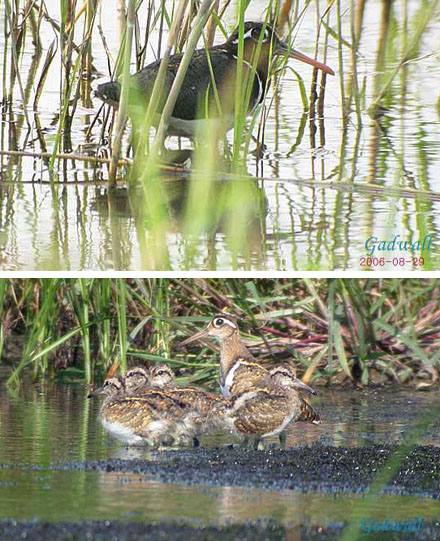
Male and juveniles (bottom) September)
Photos © Kim Beom-Su
Seosan, September 13
In the (failed) hope of an early Pied Harrier, the day spent driving aroung Seosan Lakes A and B. In total c 65 species logged, with local/seasonal highlights including 2 Black-necked and (already) c 75 Great Crested Grebes, 15 Ruddy Shelduck, c 75 Baikal Teal, 150 Great Knot (at the top end of Lake A), c 100 Mongolian Gull along with 2+ Vega and a single taimyrensis type, c 20 Pechora and at least 3 Red-throated Pipits.
Of further note, a tape of Zitting Cisticola recorded in Europe failed to produce any kind of reaction from local birds, while an immediate response was provoked by a short burst of a recording made in Japan - with one singing bird flying across the rice-field to within a few meters of us. It is clear that with such completely different songs, obvious differences in plumage and even behaviour, that so-called Zitting Cisticola is yet another species in need of taxonomic revision.
One further highlight was provided in the form of excellent views of an Amur Leopard Cat, perhaps over-ambitiously eyeing a group of Ruddy Shelduck feeding in a cut-rice field.
Heuksan Island, September 12
The morning spent birding with Park Jong-Gil (who informed us of more odd juvenile shrikes, possibly Isabelline?, being banded on Hong Island in recent days), and again around 55 species logged during the day.
Highlights included one or two Light-vented Bulbul (second autumn record for the southwest islands), another Latham's Snipe (this one calling), 4 Richard's and c 8 Pechora Pipit, a Yellow-breasted Bunting and good views of a Middendorff's Grasshopper Warbler.
While excellent views were enjoyed of a juvenile Japanese Bush Warbler (washed yellow below, apparently unlike juvenile borealis Bush Warbler), more intriguing still was a Sakhalin/Pale-legged Leaf Warbler calling far more softly than expected for Pale-legged (more of a huip than a pttii note). Comparison soon after with recordings produced an excellent match with Sakhalin Leaf.
From the ferry back to Mokpo, c 700 Streaked Shearwater logged.
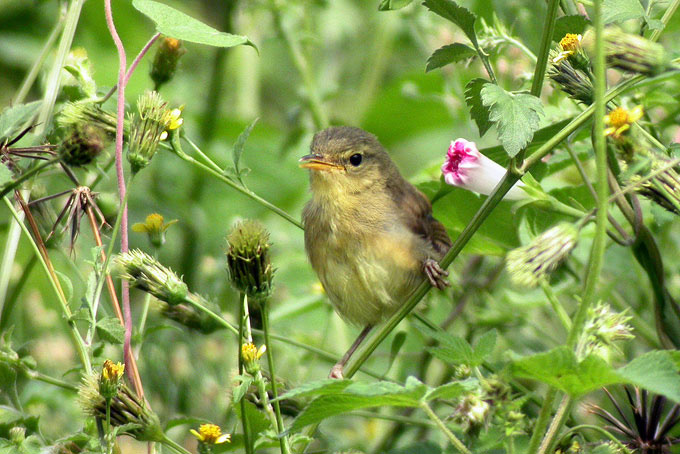
Songdo & Siheung, September 12
A stupendous 47 Black-faced Spoonbills (including some juveniles) and c. 230 Black-tailed Godwits crowded onto the lagoon today, both record counts for Songdo. Although encouraging, it probably indicates that more birds now find themselves concentrated in one undisturbed spot, rather than spread out over the large areas of mudflats that have recently been reclaimed. Other birds of note here were a few Long-toed Stints and Sharp-tailed Sandpipers, the lone Ruff, and an Asian Brown Flycatcher in the trees.
At Siheung reservoir over the past 3 days, excellent views of a very approachable Yellow Bittern, as well as a Great-Crested Grebe, and Black-naped Orioles, Grey-headed Woodpeckers & Kestrels in nearby woodland.
Heuksan Island, September 11
An early morning start produced very decent flight views of 2 Black Woodpigeon out of the 4 or 5 heard, while other highlights included excellent views of 2 Long-toed Stint, one presumed menzbieri and 2 gustavi Pechora, a single Blue-and-White Flycatcher, the personal first Little, Yellow-browed (2) and Black-faced Buntings of the autumn, and both Chestnut-cheeked (2) and Daurian Starling (1).
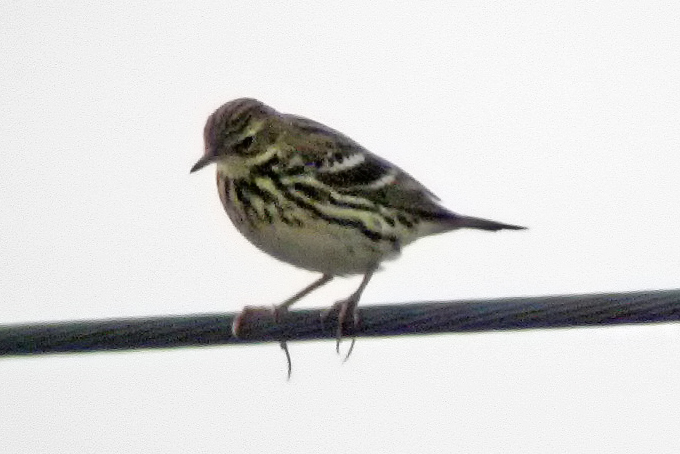
Heuksan Island, September 10
With strong winds leading to the Socheong boat being cancelled, we turned back south, and took the ferry across to Heuksan. In total, ca 54 species for the day, including 299 Streaked Shearwater seen in a single scan off the NE of the island, adult White-tailed Eagle, 2 Latham's and one Pintail Snipe, and a Black-winged Stilt.
Numbers of resident (or near-resident) species like Japanese White-eye (150+) and Pale Thrush (25) seemed atypically high, while there were still rather few autumn migrants (e.g. although there were 30 Chinese Grosbeak there were just single Pechora Pipit and Brown Shrike logged, along with only one Dusky, 3 Yellow-browed and 6 Arctic Warblers etc).
Potentially best for the day, but seen too poorly to claim with any confidence, was a presumed male Black-winged Cuckooshrike.
Gunsan vicinity, September 10
On the mud flats in the Industrial Zone were 82 Eastern Oystercatchers, 88 Kentish Plovers (majority if not all juvenile), and a smattering of Far-Eastern Curlews, Black-tailed Godwits etc. In the canal, there were Marsh, Green and Wood Sandpipers but the highlights were one Ruff and a Common Snipe.
From 'the corner' on the south side of the Geum, c. 1,000 Black-tailed Godwits were sighted, along with c. 195 Black-tailed and 7 Black-headed Gulls. Also seen were Red-necked Stints, a Common Kingfisher, Spotted and Common Redshank. As the high tide pushed them out of the Geum, we followed them around to Weol-po and found a nice collection of species there, including c. 150 Great Knot, a single Eurasian Curlew and a number of Grey-tailed Tattlers.
The day was finished off well at Oh-song pond with 61 Azure-winged Magpies, a Black-capped Kingfisher, the resident Little Grebes, a Cuckoo species, 2 Black-naped Orioles and a calling Bull-headed Shrike, making 51 species for the day.
Seosan, September 10
A cool autumn breeze is in the air. In rice fields a Yellow-breasted Bunting restlessly flighting overhead, and a Japanese Quail, Oriental Greenfinches, 2 Yellow Wagtails, a Common Kingfisher, Common Snipe, Oriental Reed Warblers and a hunting Northern Hobby.
On Lake A, a full entourage of waders included Black-tailed Godwits, Red-necked Stints, Marsh Sandpipers, Spotted Redshanks, Long-toed Stints, Sharp-tailed Sandpipers, Great Knots, 10+ Grey-tailed Tattlers, Dunlins, Grey Plovers, Terek Sandpipers, Mongolian Plovers, Common Greenshanks, Red Knots, Far-Eastern & Eurasian Curlews, "Eastern" Oystercatchers, Common Sandpipers, numerous Whimbrels, and Bar-tailed Godwits. Also, plentiful Black-headed and Mongolian Gulls now.
Also seen: a Mamushi/ Korean Viper Agkistrodon caliginosus beside the road.
Seungbongdo and Songdo, September 8 - 10
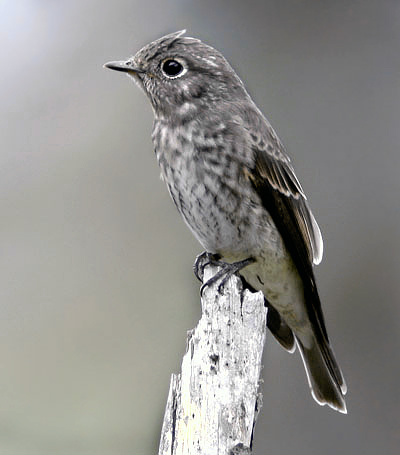
A trip out to Seungbongdo found the island extremely quiet (birdwise) despite much searching in all kinds of weather. The 8th was hot, humid, and windless. Jays were numerous. Highlights were single Grey-streaked and Tricoloured Flycatchers, a Chinese Pond Heron, small numbers of Sharp-tailed, Wood, and Common Sandpipers, a pair of Northern Hobbies (seen chasing a Barn Swallow the following day) and a Black-capped Kingfisher.
The evening brought out a Grey Nightjar, 5 Oriental and 1 Collared Scops Owl (all owls heard only).
The 9th began with a steady, light rain, and few new birds noted, even when the rain ended with much cooler conditions; the best were a splendid view of a Grey Nightjar, which flushed then fluttered down to perch lengthwise on a pine branch, a Long-toed Stint, and a Pintail Snipe.
A few hours before the ferry on the 10th added only a Yellow-browed Warbler (heard) and a Common Kingfisher.
Best bird of the weekend was back on the mainland. A quick stop at Incheon's consistently productive Dongmak freshwater lagoon found a juvenile male Ruff among many of the same waders seen there last week: good numbers of Marsh Sandpipers (25+), several Common and Sharp-tailed Sandpipers, somewhat reduced numbers of Black-tailed Godwits, and a single Long-toed Stint. The entire shorebird flock flushed and flew off when a Peregrine passed by. Also out on the water, a sign of season's change: several Pochards and 2 Eurasian Wigeon.
Seosan A (Gunsan), September 9
A calm overcast day changed to wind and light rain as a vigorous cold front swept in, dropping afternoon temperatures down to 21 C.
At Seosan A, 60 species, with highlights including a single Black-faced Spoonbill with 3 Eurasian Spoonbill, good views of a streaky-type Middendorff's Grasshopper Warbler, 11+ Baikal Teal, 3 Long-toed Stint, single Ruff and Common Redshank, and 2 Latham's Snipe. In addition, many more hirundines around, with probably over 1000 seen during the day, and personal first Yellow-browed Warbler of the autumn.
Okgu, Saemangeum, September 8
A boat ride out to the offshore island, with c 10 hours of shorebirdwatching in strong sunlight and warm temperatures.
Clearly, the area is degrading rapidly, with many fewer crabs than in May and no live shellfish seen. In total, ca 12000 shorebirds of 29 species seen, with now only 150 Great Knot. Most numerous were Dunlin (5000), Mongolian Plover (3 200) and Red-necked Stint (2000, with all but 20 juveniles: an extraordinary adult-juv ratio), with other species of note including 400 Broad-billed Sandpiper, 20+ Red Knot (with one bird carrying two flags on the right leg - creamy yellow or dirty white on tibia and black on tarsus), 2 Greater Sand Plover, a yellow-flagged Bar-tailed Godwit and 2 Long-toed Stint.
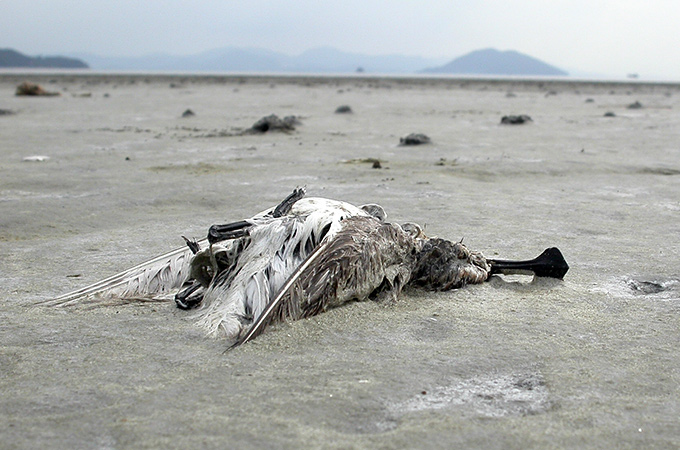
Mr. Ju Yong-Gi found no less than 20 dead birds in total (in varying states of decomposition), including especially depressingly an adult Spoon-billed Sandpiper (moving from breeding into non-breeding plumage). Much better, he also found the first live Spoon-billed Sandpiper (a juvenile), which then joined three more juveniles before all the shorebirds were flushed by a passing Northern Hobby.
Yeongjong Island, September 7
Despite lots of construction work nearby, a very good high tide roost, with both quantity and quality. Highlight was prolonged views in excellent light of 2 adult Nordmann's Greenshank, while other excellent species at the same roost included at least 38 Chinese Egret, 2 Black-faced Spoonbill (with another 8 nearby) and c 25 Saunders's Gull.
These Yellow Sea specials were also supported by decent numbers of Far Eastern Curlew (1900), Grey Plover (700), Dunlin (2000) and Great Knot (500), with smaller numbers of Bar-tailed Godwit (200, including a male with yellow flag on right tibia), Common Greenshank (95), Terek Sandpiper (75), and Eastern Black-tailed Godwit (30) etc.
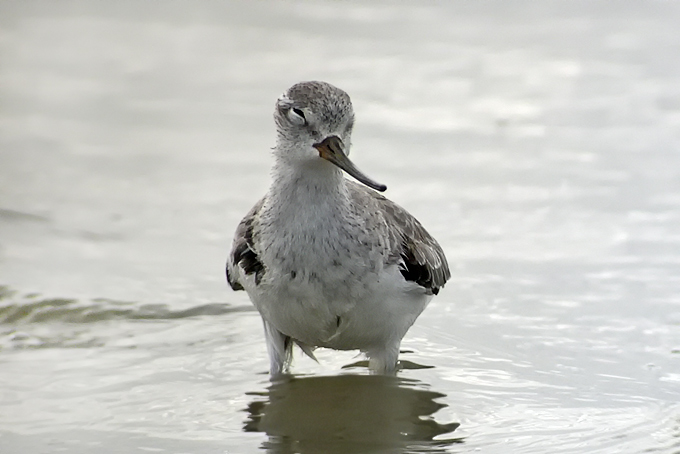
Shiripdae, September 5
The woods were mercifully undisturbed and quiet today in this corner of Seoul. Highlight was a Radde's Warbler watched at very close range catching insects in low foliage. Otherwise a Great-spotted Woodpecker family, White-backed Woodpecker, Pale Thrush & Grey-headed Woodpecker.
Geum Estuary, August 29
In among several thousand shorebirds roosting at shellfish harbour, 3 Chinese leg-flagged Great Knot, with one white over black and two black over white (i.e. banded this spring at the Yangtze Estuary, China), as well as two yellow-flagged Great Knot and two yellow-flagged Bar-tailed Godwit.
Geum barrage and Saemangeum (Dongjin and Okgu), September 3
In hot and sunny weather, the Geum barrage at high (neap) tide was reasonably productive with high tens of Terek and Greenshank, (Eastern) Black-tailed Godwit and Far Eastern Curlew, and highlights including 5+ Broad-billed Sandpiper, single Long-toed Stint and Greater Sand Plover, 5 Eastern Oystercatcher, 4 Common Redshank, 5 Red Knot and 7 Great Knot.
At Saemangeum, the first area visited was west of Simpo where Mr. Ju Yong-Gi had seen ca 15000 shorebirds 2 weeks previous. In total, over 1000 Common Greenshank, and low hundreds of Grey Plover and Red-necked Stint. At Simpo itself, further evidence that the tidal range has been further reduced, with most of the flats now resembling a sandy beach, replete with soccer-playing children and beach umbrella...A quick visit to Okgu and a long-range count of ca 4 900 shorebirds, including 1 200 Great Knot (with much of the remainder made up of Grey Plover, Common Greenshank, (Eastern) Black-tailed Godwit, and Red-necked Stint).
Other species of note in the Saemangeum area included 11 Black-faced Spoonbill, an Osprey, 3 Little Tern, single Sand Martin, ca 20 Eastern Yellow Wagtail and a single fly-over Pechora Pipit, giving the much thicker, "Chep" type call typically associated with (presumed) menzbieri.
Songdo, September 3,
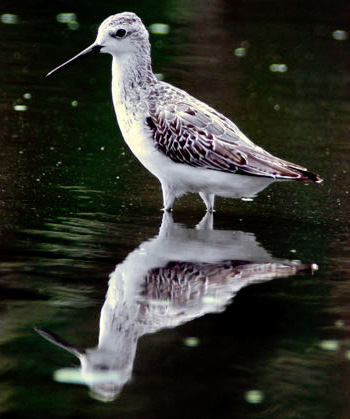
The freshwater lagoon was scoured by a host of autumnal waders: prolonged views of 2, possibly 3 Temminck's Stint in good light: a bird probably much overlooked here in former visits. A good scattering of Long-toed, 1 Red-necked and a possible Little Stint picked through the marsh, likewise several Common, Sharp-tailed, Wood and Marsh Sandpipers. Also c.20 Black-tailed Godwits, a Spotted Redshank, Common Greenshanks and 6 Pacific Golden Plovers looking somewhat dark and worn, in full moult.
The first first returning Common Shelduck has appeared, likewise plenty of Shovelers, a few Pintails, 6 Garganey showing well and a Mandarin, all in moult and eclipse.
At Ahamdo it seems fresh construction may already have walled off any incoming tide and doomed the final stretch of mudflat: despite this, a few Bar-tailed and another c.30 Black-tailed Godwits, amongst Whimbrels and Far-eastern Curlews.
On the overgrown golf course, typical summer birds are still present: several Black-naped Orioles, a Barn Swallow, Grey Wagtail and seemingly abundant cuckoos, both adults and juveniles. Good views of a heavily barred juvenile Indian, a Little, and plenty of Eurasian Cuckoos would seem to indicate their passage through this coastal area. Migrants are very apparent now, with Asian Brown, Grey-streaked and Yellow-rumped Flycatchers in the willows: also 2 Eastern-crowned and 2 Arctic Warblers, and a Yellow Wagtail. Finally, excellent views of an obliging Brown Hawk Owl/ Northern Boobok added to a very respectable days total.
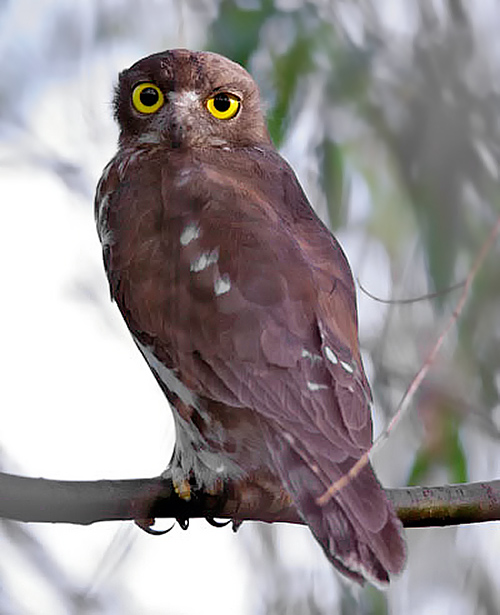
Geum Estuary, and Upstream, September 2
With a neap tide, few shorebirds noted on the Geum near the barrage by the 12 or so observers present (including several first-time birdwatchers), although of especial note were single Vega Gull, and 200+ Great Knot (the largest number seen at this site: possibly birds displaced from Saemangeum?). Moving up stream, a small reservoir held breeding Little Grebe, as well as in neighboring open woodland Bull-headed Shrike, Broad-billed Roller, 3 Northern Hobby and best of all 25+ White-throated Needletail Swift.





